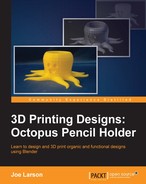Book Description
Learn to design and 3D print organic and functional designs using Blender
About This Book
- Learn how to make complex shapes by editing basic ones
- Make printable objects from multiple shapes and parts
- Learn how to design from scratch, without a reference to physical objects
Who This Book Is For
You should have basic knowledge of Blender and 3D printing and be interested in printing your first object.
What You Will Learn
- Get to know the guiding principles required to create 3D printer-friendly models
- Understand material characteristics, printing specifications, tolerances, and design tips
- Master the art of modifying basic shapes with Blender's powerful editing tools: extrude, loop cuts, and other transformations
- Learn techniques of editing complex meshes, smoothing, combining shapes, and exporting them into STL files for printing
In Detail
This book will cover the very basic but essential techniques you need to model an organic and functional object for 3D printing using Blender.
Starting with pen and paper and then moving on to the computer, you will create your first project in Blender, add basic geometric shapes, and use techniques such as extruding and subdividing to transform these shapes into complex meshes. You will learn how modifiers can automatically refine the shape further and combine multiple shapes into a single 3D printable model.
By the end of the book, you will have gained enough practical hands-on experience to be able to create a 3D printable object of your choice, which in this case is a 3D print-ready octopus pencil holder.
Style and approach
This is a starter project designed to introduce you to your first real-world 3D printing designs, where you'll learn how to handle the fundamental principles of 3D printing design and have your hands on your reward in no time.
Downloading the example code for this book. You can download the example code files for all Packt books you have purchased from your account at http://www.PacktPub.com. If you purchased this book elsewhere, you can visit http://www.PacktPub.com/support and register to have the code file.
Table of Contents
- 3D Printing Designs: Octopus Pencil Holder
- Table of Contents
- 3D Printing Designs: Octopus Pencil Holder
- Credits
- About the Author
- About the Reviewer
- www.PacktPub.com
- Preface
- 1. 3D Printing Basics
- 2. Beginning Blender
- 3. The Octopus Pencil Holder
- Index
